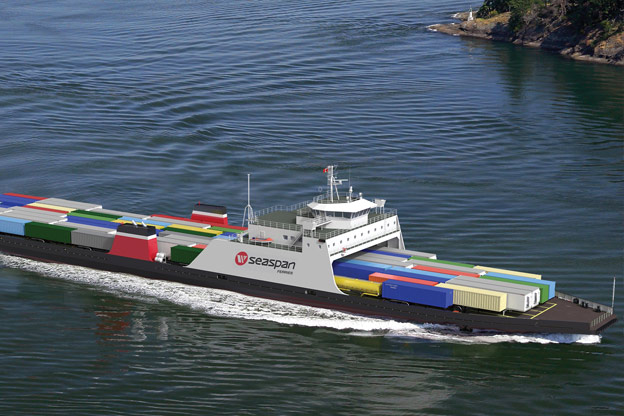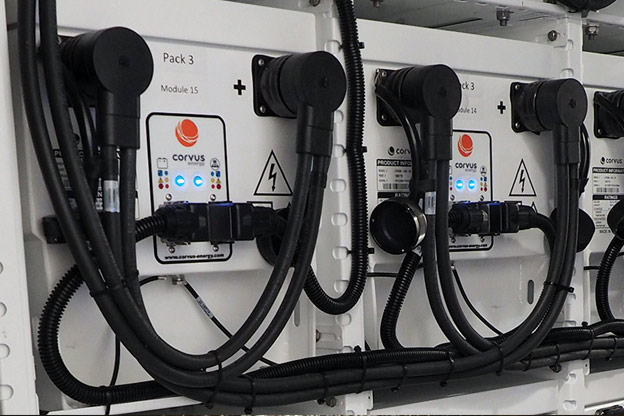First Hybrid Ferry Arrives to the Salish Sea, Natural Gas Rises, and Canadian Super Batteries Reign
 Greener technology appears to be making several inroads with the maritime industry, whether we are talking about ferries, submersibles, or even tall ships. I used to see the word “hybrid” and think of a really efficient, low-emission passenger car like the Toyota Prius, the world’s first mass-produced hybrid. This breakthrough design happens to be 20 years old this year, and four million of them have been sold. They are now fitted with an 1800 cc petrol engine, a 120-pound battery bank, and an electric motor. The combination gets 50 mpg on the highway and creeps silently around parking lots in electric mode all around the world. In contrast, the total number of hybrid boats on the water is likely no more than a few hundred. You may reasonably wonder why the boating industry hasn’t taken advantage of this technology. The reason is that the typical power boat gets very little use compared to a car and has a lot of hydro-dynamic resistance to overcome at higher than displacement (low) speeds. So the weight, expense, and complexity of a hybrid drive make it a less than compelling eco-option. Thanks to advances in battery banks and liquid natural gas (LNG) engines, we’re seeing new, eco-friendly designs in both our local waters and abroad.
Greener technology appears to be making several inroads with the maritime industry, whether we are talking about ferries, submersibles, or even tall ships. I used to see the word “hybrid” and think of a really efficient, low-emission passenger car like the Toyota Prius, the world’s first mass-produced hybrid. This breakthrough design happens to be 20 years old this year, and four million of them have been sold. They are now fitted with an 1800 cc petrol engine, a 120-pound battery bank, and an electric motor. The combination gets 50 mpg on the highway and creeps silently around parking lots in electric mode all around the world. In contrast, the total number of hybrid boats on the water is likely no more than a few hundred. You may reasonably wonder why the boating industry hasn’t taken advantage of this technology. The reason is that the typical power boat gets very little use compared to a car and has a lot of hydro-dynamic resistance to overcome at higher than displacement (low) speeds. So the weight, expense, and complexity of a hybrid drive make it a less than compelling eco-option. Thanks to advances in battery banks and liquid natural gas (LNG) engines, we’re seeing new, eco-friendly designs in both our local waters and abroad.
Seaspan Ferries and LNG Fuel
The best candidate for a marine hybridization turns out to be the complete opposite of a typical motor boat–a big ferry that can handle a large, heavy battery bank and runs daily on a short route. That gives it a chance to use the low power electric drive several times a day when maneuvering and to boost the speed if it is heavily loaded or running behind schedule.
There are quite a few ferry routes on the Salish Sea that fit those conditions, but the ferry services of Washington and British Columbia are already dependent on government funds to make up their operating losses and pay for new construction. They aren’t about to take any risks by adopting expensive emerging technologies to make an ecological statement. But Seaspan Ferries is a private corporation that operates a drop-trailer service on the 40-nautical mile crossing between British Columbia’s Lower Mainland and Vancouver Island with three roll-on/roll-off ferries and four articulated tug and barge units. They carry more than 800 trailers a day, over 50% of all cargo to Vancouver Island, and needed to increase their capacity.
Seaspan wanted a concept that would reduce its greenhouse gas emissions dramatically while delivering the highest level of efficiency, performance, and reliability. Naval architects VARD is one of the major global designers and shipbuilders of offshore and specialized vessels. With headquarters in Norway, the company has extensive experience in alternative power systems, which are becoming popular in Scandinavia. VARD produced the designs for the first diesel-electric hybrid vehicle ferry in North America—the 488-foot by 85-foot Seaspan Swift–capable of transporting 59 trailers (double the existing boats), six crew, and 12 passengers. Loaded displacement is 6,750 tonnes.
Seaspan’s shipyard is one of the most modern in North America after being completely upgraded with over $120 million worth of infrastructure to construct Canada’s new National Shipbuilding Procurement Strategy Non-Combat vessels. But Seaspan’s Shipyard is fully booked for the next five to seven years and is presently outfitting the first 282′ Offshore Oceanographic Science Vessel. The contract for two identical vessels was put out to bid and won by Sedef Shipyard in Istanbul, the biggest yard in Turkey. The first vessel arrived after an eight-week journey that spanned a total of 10,660 nautical miles. The second, Seaspan Reliant, is due in the spring of 2017.
The heart and soul of the new ferries is their main engines— twin 9L34DF dual-fuel engines by Finnish company Wärtsilä coupled to constant-speed 1050VDC generators with Wärtsilä LNGPac fuel systems. The combination produces 9,000 kW at 750 rpm at the two azimuthing (z) drives for a maximum speed of 16 knots.
Dual-fuel engines burn diesel for the primary ignition and LNG for combustion. LNG is the same fuel used to heat our homes and cook our meals. LNG is natural gas that has been cooled to -256 degrees Fahrenheit, at which point it is condensed into a colorless, odorless, non-toxic, and non-corrosive liquid. In its liquefied form it occupies 1/640th of its original volume, which makes it easier to transport and store.
The LNG tank is refueled by a tanker truck that drives on board before the ship is loaded. Natural gas is the cleanest burning fossil fuel, reducing NO (nitrogen oxides), CO (carbon dioxides), SO (sulfur oxides), and PM (particulate matter) to meet current and pending environmental regulations. “Seaspan Ferries is thrilled to welcome the Seaspan Swift, a state-of-the-art, technologically advanced vessel to our fleet,” said Steve Roth, Vice President of Seaspan Ferries Corporation.
LNG Coming to NW Ferries
Three Salish Class vessels are being built at Remontowa Shipbuilding S.A. in Gdansk, Poland and the first is scheduled to be in service for the summer of 2017. These new vessels are capable of running as dual-fuel on either natural gas or ultra-low sulfur diesel. Use of natural gas will result in the reduction of an estimated 9,000 metric tons of carbon dioxide equivalent per year, which is the same as taking 1,900 passenger vehicles off the road annually. The Salish Orca arrived in B.C. in mid-January and by spring it will be in service between Comox and Powell River, replacing the 51-year-old Queen of Burnaby.
Washington State Ferries (WSF) has been conducting analysis, evaluation, and detailed studies on the viability of using LNG as a source of fuel for our fleet. LNG is used world-wide in marine applications and provides an opportunity to reduce fuel costs and better the environment by decreasing emissions. WSF issued a request for proposal for a design-and-build contract to convert the propulsion system of a maximum of six Issaquah Class auto/passenger ferries from diesel fuel to LNG-only fuel, or to dual diesel and LNG fuel.
Corvus Batteries
 LNG technology is not all that has advanced. Corvus is an up-and-coming Canadian battery business based in Richmond, B.C. near the U.S. border. Founded in 2009, the company focused on developing batteries that could withstand the wet, corrosive environment of the ocean. Since then, it has come to dominate the marine market, with 25 MWh of its batteries currently being used in 35 ships across Northern Europe. Corvus recently received an investment from Statoil, Norway’s largest offshore oil company.
LNG technology is not all that has advanced. Corvus is an up-and-coming Canadian battery business based in Richmond, B.C. near the U.S. border. Founded in 2009, the company focused on developing batteries that could withstand the wet, corrosive environment of the ocean. Since then, it has come to dominate the marine market, with 25 MWh of its batteries currently being used in 35 ships across Northern Europe. Corvus recently received an investment from Statoil, Norway’s largest offshore oil company.
In Norway, more and more ferries and oil-service ships are running either partially or entirely on battery power. Some ferries on fjords in remote areas dock at small ports that are supplied with electric power from local streams, and make the crossing on 100% electrical power and plug in to recharge until they start the return trip. Norway is such an important market that Corvus has opened an office there.
“We’ve got the largest install base, by far, in marine – something approaching 70% of the installed base in the marine and offshore world is Corvus,” said Corvus CEO Andrew Morden. “We’re very pleased to have our product deployed locally for the first time.”
The battery banks consist of 84 Corvus Energy AT6500 advanced lithium-ion polymer packs storing 546kW hours. The complete package is called the Energy Storage System (ESS) and does not require active cooling techniques such as liquid cooling to be effective. There is an ESS on the new 83.50-meter prize-winning Feadship megayacht Savannah, and the company has also supplied lithium-ion batteries for a number of other transportation sectors, including trains, trucks, and submarines. Morden thinks there is a big potential market for energy storage in offshore wind farms, trains, and light-rail systems. Corvus battery systems are even being installed in craft ranging from unmanned submersibles and educational tall ships.
The Future
Overall, greener technology is becoming more and more prevalent in all aspects of the maritime industry, and not necessarily for altruistic reasons. In many applications, electric and dual-fuel engines are a savvy move for companies to win customers and make money, and for societies to become more efficient. Time will tell, especially with the new American administration, how this trend will continue in the U.S., but from where I write, greener, more efficient maritime future seems inevitable.


